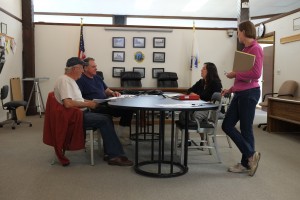The Marion Planning Board’s Solar Bylaw Subcommittee met on Wednesday afternoon in an effort to finalize the body’s official opinion on the Solar Bylaw to be presented at fall Town Meeting on October 28. But before that, the board will consider the subcommittee’s findings at its next scheduled meeting on October 7.
Members Steve Kokkins and Rico Ferrari comprise the subcommittee, and were joined by Energy Management Committee member Jennifer Francis in an unofficial capacity.
The Solar Bylaw passed in part during annual Town Meeting in May, when voters approved a municipal solar overlay district allowing for a community solar garden at the defunct town landfill. The portion of the bylaw regulating residential installations, meanwhile, narrowly failed by a handful of votes, as the Planning Board registered its opposition to it on the floor.
However, in the months since, the Planning Board and the EMC have reached a compromise when it comes to the special permit process for residential installations, and the groups have already decided that they will jointly recommend that segment of the revised bylaw at fall Town Meeting.
Currently, the last remaining hurdle is how the Planning Board will handle the Solar Bylaw’s language regarding the regulation of solar farms in residential areas. A vast majority – upward of 97 percent – of Marion is zoned residential. Currently, the bylaw allows solar farms provided conditions are met. But the Planning Board is split on this portion of the bylaw: Some members oppose solar farms in residential areas altogether; others are lukewarm, preferring an overlay system to be determined; and still others are in favor.
In turn, the subcommittee is attempting to hammer out a resolution on solar farms in residential areas. The Planning Board is working with three paths: the unlikeliest is a nuclear option to reject the Solar Bylaw in toto; another is to recommend the bylaw as is; and the third is to advise Town Meeting voters to amend the bylaw on the floor by removing the solar farms provision and replacing it with an overlay system at annual Town Meeting in the spring.
On Wednesday, Kokkins and Ferrari brought that debate into better focus by dividing up responsibilities: Kokkins will argue to the Planning Board that they should recommend amendment and removal at Town Meeting, while Ferrari will argue for recommendation of passage.
“Personally, many people have told me that they are quite uncomfortable with having commercial operations of any kind in residential areas,” said Kokkins, previewing his argument. “The concept of an overlay is to provide some flexibility by not zoning on an inch by inch basis. This still shows the state that the town is in favor of progress.”
Ferrari was mum on the case he would make to his Planning Board colleagues, saying that the Solar Bylaw conundrum “wakes him up at 3 in the morning all of the time,” but Francis was there to file an amicus brief, as it were.
“Practically speaking, we’re talking about maybe a handful of applications for solar farms in residential areas,” Francis said. “You can evaluate these thing when they’re applied for. It seems like a way more efficient use of your time.
“An overlay – whenever the town will actually come up with one – is going to exclude people who want and would otherwise be able to,” added Francis, lamenting the possibility of an overly onerous process.
The Planning Board’s Solar Bylaw Subcommittee is scheduled to next meet on September 30 at 7:00 pm. At that point, Ferrari and Kokkins will crystallize their arguments for the Planning Board, which will presumably decide on a course of action in time for the October 28 Town Meeting.
By Shawn Badgley
